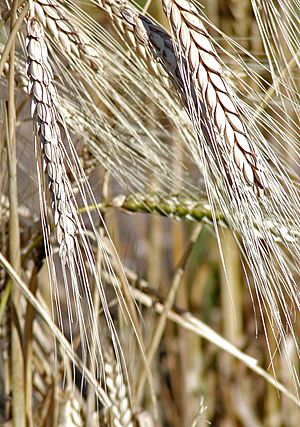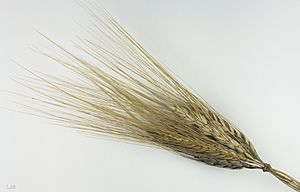Khorasan wheat facts for kids
Quick facts for kids Khorasan wheat |
|
|---|---|
 |
|
| Scientific classification | |
| Genus: |
Triticum
|
| Species: |
turanicum
|
| Synonyms | |
Khorasan wheat is a special type of wheat. It is also known as Oriental wheat. Its scientific name is Triticum turgidum ssp. turanicum. You might know it by its brand name, Kamut.
This grain is much bigger than the wheat we usually see. It has a rich, nutty taste. Khorasan wheat is a very old grain. It is known for its good nutrition.
Contents
What is Khorasan Wheat?
Khorasan wheat is a type of grass. It grows every year, just like other wheat. Farmers grow it for its grains. These grains are about twice the size of regular wheat kernels.
A thousand of these kernels can weigh up to 60 grams (2.1 ounces). They are amber in color. They are also very hard and shiny.
Where Does It Grow?
Khorasan wheat is grown in different parts of the world. In Europe, it is mostly used to make bread. In the province of Khorasan in Iran, it is sometimes used as food for camels.
It is also grown in small amounts in other parts of the Middle East. Farmers often grow it for their own families.
How Much Does It Grow?
Khorasan wheat does not produce as much grain as other types of wheat. On average, a field yields about 1.1 to 1.3 tons per hectare. This is less than durum wheat in good years.
However, in dry years, Khorasan wheat can sometimes grow better than durum wheat. This is because it handles dry weather well.
Why Is It Special?
Khorasan wheat is not a major crop worldwide. Only about 16,000 acres are grown. This is a very small amount compared to other grains.
Because it is not grown everywhere, it fills a special market. This helps farmers who grow it. It makes up for the fact that it doesn't yield as much.
What Can You Make with It?
You can use Khorasan wheat just like regular wheat. Its grains can be eaten whole. You can also grind them into flour.
It is used in many foods. You can find it in breads, breakfast cereals, and cookies. It's also in waffles, pancakes, and pasta. Some people even use it to make drinks and beer.
Besides being healthy, people like Khorasan wheat for its smooth feel. It also has a unique nutty, buttery taste.
Nutrients in Khorasan Wheat
Khorasan wheat is packed with good stuff for your body. A 100-gram serving has about 337 calories. It is full of important nutrients.
It has a lot of protein (29% of what you need daily). It also has a lot of dietary fiber (46% daily). You'll find many B vitamins and dietary minerals in it. For example, it has a lot of manganese.
Khorasan wheat is about 11% water, 70% carbohydrates, 2% fat, and 15% protein. Its high protein content helps make good flour.
Gluten Content
Like all wheat, Khorasan wheat contains gluten. Gluten is a type of protein. Because of this, it is not good for everyone.
People with certain health issues cannot eat gluten. This includes those with celiac disease or wheat allergy. They need to avoid Khorasan wheat.
Growing Conditions
Khorasan wheat likes a certain kind of weather. It prefers a mild climate with cold nights in early spring. It also needs low to medium rainfall (500–1,000 mm per year). A sunny, warm summer is best for the grains to ripen.
These conditions are similar to what durum wheat needs. Khorasan wheat is very good at handling dry weather. It can even do better than durum wheat when it's dry. Too much rain, especially later in the season, can cause problems with diseases.
The best soils for Khorasan wheat are deep, loose, black clays. These soils can hold a lot of water.
How Farmers Grow and Harvest It
Growing Khorasan wheat is much like growing other wheat. Most Khorasan wheat is grown organically. This means farmers use natural ways to add nutrients to the soil. They might plant legumes (like beans or peas) before the wheat.
The nutrients are very important for this crop. They help the wheat grow healthy and full of good things.
Harvesting is also similar to other wheat. When the grains are ready, a combine harvester collects them. However, Khorasan wheat grains are very delicate. They can break easily. So, farmers must be extra careful when harvesting and handling them.
Storing these grains can also be tricky. They might hold more water. The milling process needs to be adjusted because the grains are so big. Also, the machinery used for moving the grains must handle their heavier weight.
Plant Health: Diseases
Khorasan wheat can get the same diseases as other wheat types. Most diseases are caused by fungi. Examples include Fusarium head blight and "black tip." Khorasan wheat is quite sensitive to Fusarium head blight.
To prevent diseases, farmers use crop rotation. This means they plant different crops in the same field each year. This helps keep the soil healthy and reduces disease. For example, they might avoid planting Khorasan wheat after corn or other cereals.
Good crops to rotate with Khorasan wheat include canola, sunflower, and pulses.
The Kamut Brand
KAMUT is a special brand name. It is owned by a company in Montana, USA. This company was started by Bob Quinn. He is a scientist who studies plants and an organic farmer.
The name "Kamut" is used for a specific type of Khorasan wheat. If you see "Kamut" on a product, it means it meets certain rules. The company makes sure it is grown and sold in a special way.
The wheat was first registered in 1990. It was called "QK-77" by the United States Department of Agriculture. It was even sold at fairs as "King Tut wheat." The word Kamut comes from an ancient Egyptian word for "wheat."
See also
 In Spanish: Trigo de Jorasán para niños
In Spanish: Trigo de Jorasán para niños


